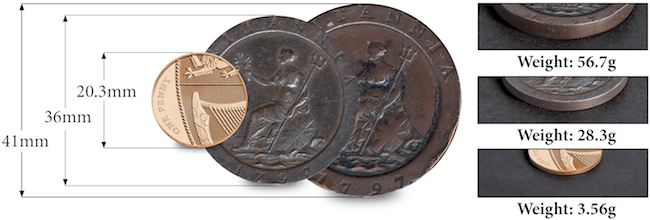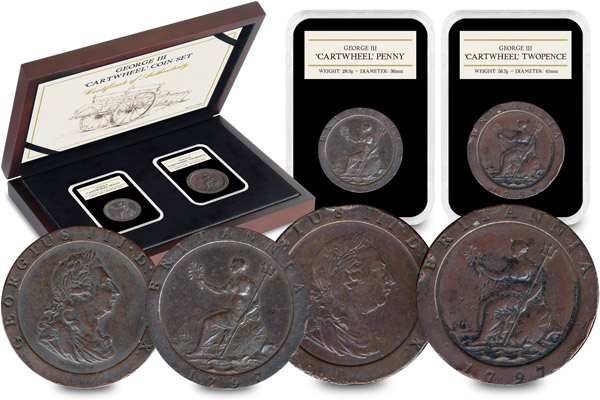Posts Tagged ‘Coin collection’
How rare is my 50p and how much is it worth?
As a collector, there’s no better feeling than finding a sought-after 50p in your change! But with over 76 different 50p coin designs in circulation, how can you tell which ones are worth looking out for?
Luckily for you, we’ve done the hard work and compiled a number of resources to help you determine how rare your 50p is and how much it might be worth.

Mintages
A sure fire way to know if you’ve found a keeper is to check the mintage figures for your 50p. Generally speaking, the lower the mintage, the rarer the coin and the harder it will be to find in circulation.
Here is the most up to date mintage chart for UK 50p coins in circulation, with the UK’s rarest circulation 50p – the 2023 Salmon 50p – right at the top. The Salmon 50p recently overtook the Kew Gardens 50p as the rarest 50p when it was announced in October 2024 that only 200,000 of them are in circulation – 10,000 less than the 2009 Kew Gardens 50p!

In third place is the 2018 Peter Rabbit 50p with a mintage of 1,400,000, a huge jump up from the tiny mintage figures of the Salmon and Kew Gardens 50ps!
Click here to read more about the 50p mintage figures >>
eBay Tracker
Mintage figures are a great way to find out how many of a certain coin were released into circulation and therefore, how difficult it might be to find – but this doesn’t necessarily give you a value for your coin. One way in which you can determine what your coin might be worth, is to look at how much it’s sold for on secondary market sites such as eBay.
Again, we’ve made things easy for you by taking the last 9 sold prices achieved on eBay for the top 10 coins and banknotes and giving you the median selling price. By taking the median, rather than an average, we avoid one or two excessive prices skewing the figures.

Our latest eBay Tracker update revealed that the rarest circulating 50p – the 2023 Salmon 50p – could fetch you up to £83.60 on the secondary market. However, a 2009 Kew Gardens 50p will still set you back over £140, despite no longer being the rarest 50p.
You can also see that the undated 20p, known as the ‘holy grail of change collecting’, is selling for a median of £64 – not a bad return on a 20p coin!
Read our latest eBay Tracker Update >>
Don’t see your coin on the eBay Tracker? You can use our 6 Point Guide to valuing your coins to determine how much they could be worth.
Change Checker’s Scarcity Index
Mintage figures only tell part of the story when determining how scarce and sought-after the coins in your collection are. That’s why we created the Change Checker Scarcity Index to give you a complete picture of how your coin compares to other 50ps in circulation.
We combine a coin’s mintage figure with how many collectors have listed the coin as being in their collection on the Change Checker App, and the number of times the coin has been requested as a swap on our Swap Centre.

Our latest Scarcity Index for 50p coins was the first one to feature the 2023 Salmon 50p, so the Kew Gardens 50p remains at the top whilst the Salmon 50p establishes itself as the new rarest 50p.
So how rare is your 50p?
So, now you know about the above tools, you can start to determine how rare your 50p is and how much it might be worth.
We’d love to know if you’ve found any rare coins in your change recently, so let us know in the comments below!
If you’re interested in coin collecting, our Change Checker web app is completely free to use and allows users to:
– Find and identify the coins in their pocket
– Collect and track the coins they have
– Swap their spare coins with other Change Checkers
Sign up today at: www.changechecker.org/app
The remarkable story of when a British 2 pence weighed the same as a Mars Bar…
Have you the story behind the Cartwheel Pennies? Not only are they the heaviest and largest coins ever issued for circulation, they were also issued for ONE-YEAR-ONLY.
Here’s the story…
Throughout the 18th century silver prices increased, which resulted in a substantial decrease in the amount of silver pennies that were being minted. This led to a lack of small change and businesses were finding it difficult to pay their employees with the current coinage.
Two of the largest coins ever issued in British history
Subsequently, a trend began where independent Mints started striking copper half penny and penny tokens. Most of these tokens were being minted at the ‘Soho Mint’ in Birmingham, which was actually the very first Mint to be powered by Steam.
Whilst this was not legitimate money it solved the issue and it took off – companies all over Britain were ordering personalised tokens.

Two of the largest coins ever issued in British history
However, the ‘solution’ meant there was a problem…
The British Government had lost control of the coinage. In an attempt to regain control, they instructed Soho Mint to strike 480 tonnes of copper pennies and 20 tonnes of copper twopences.
These were to be the first regal British coins of the denominations to be made of copper, and the very first official British coins to be struck using steam power.

8 times heavier than today’s 1p and 2p coins
The coins were large! In fact, the 1 pence weighed an incredible 1oz and the 2 pence weighed 2oz – that’s the same weight as a Mars Bar and almost 8 times heavier than the current 1p and 2p coins. At that size, it’s hard to believe these ever jangled in the pocket of our ancestors!
The coins weighed so much because they were struck in pure copper and their intrinsic value corresponded to their actual face value. Their design was simple – a portrait of the monarch at the time, King George III on the obverse and Britannia on the reverse.
The dramatic size of these coins and their unusually wide raised rim is why they became known as ‘Cartwheel’ pennies.

The modern 1p coin compared to the 2oz 2p coin
Issued for one-year-only
The ‘Cartwheel’ pennies were designed this way to prevent counterfeiting, but their size and weight made them cumbersome and unwieldy. They were immediately unpopular with the public as people didn’t like carrying them around – the two-pence was an INCH and three-quarters in diameter and a quarter inch thick. There were soon calls for them to be discontinued and shortly after, the coins were redesigned.
Due to the rise in the price of copper, the intrinsic value of the coins soon exceeded their face value and subsequently the majority of these coins were melted down.
This meant, the coins were issued for one-year-only, which automatically makes them two of the must-have modern coins and key coins in any British collection.
Small number of the original 200 year old ‘Cartwheel’ coins available…
We have secured a small number of sets containing the original 200 year old ‘Cartwheel’ coins – the two pence and the penny. They come presented in a deluxe presentation case with an accompanying Certificate of Authenticity. They really are key must-have coins in any British collection.
The $1 Coin Series set to become a Collecting Phenomenon…
We’ve been admiring US coinage recently and if you’ve read our previous blog detailing the series that half of American collected, you’ll be very excited to hear that starting from 2019, the United States Mint will begin minting and issuing the American Innovation $1 Coin Act – a brand new coin series honouring American innovation.
This latest numismatic programme looks set to follow on from the success and popularity of the US Territories Quarters series mentioned above, which not only kick started coin collecting in America, but worldwide!
Each coin represents its own state and will be released in the order that its respective state was ratified in the Constitution of the United States and admitted to the Union.

Candidate designs developed for the 2018 American Innovation $1 Coin Program in accordance with the Act that authorized them. Credit: www.usmint.gov
Released over a 14 year period, these coins will all bear an obverse with the Statue of Liberty and the inscriptions of “$1” and “In God We Trust”. The reverse images will be representative of a significant innovation, an innovator/group of innovators from each of the 50 states, the District of Columbia and the territories of the US. The reverse designs will be selected by the Secretary of the Treasury after consultation with each Governor, chief executive and the U.S Commission of Fine Arts.
Most excitingly, the first introductory coin is set to be released later this year! The reverse of this coin will be inscribed with “United States of America” and “American Innovators,” and it will include a representation of President George Washington’s signature on the first U.S. patent.
Following this introductory coin, the rest will be released at a rate of 4 coins per year. Just like the US State Quarters Series, The American $1 coins are expected to rapidly become one of the most widely collected series. But will you be collecting these new US $1 coins? Let us know in the comments below!
_________________________________________________________________________________________________________________________________
Start collecting US coins today!
Start your very own journey into US coin collecting with the US State Quarters that Half of America Collected…



